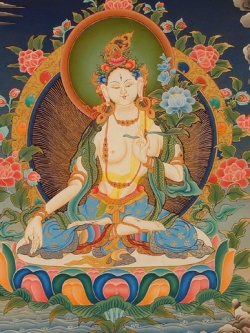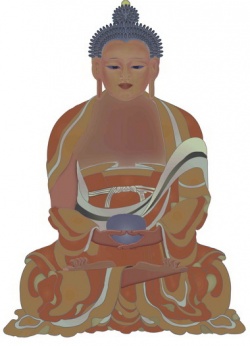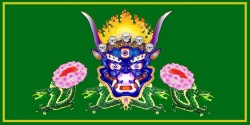The Brahma Viharas
by Dale and Barbara Verrkuilen
The Brahma Viharas are the pure abodes of the mature Zen practitioner, and the ethical conduct that is the natural outcome of embracing the Dharma and embodying its essential teachings. They are virtues of the highest order, gained by a diligent and perseverant effort in Buddhist practice. At the crux of the human condition there is a fundamental misperception, where an innate dualistic tendency splits the wholeness of life into dichotomies of subject and object, the outcome of which is the gross discomfort of alienation, and a sense of separateness from the world. This innate state can be overcome through a revolution of mind, one that replaces the fractured viewpoint of dualism with a clear understanding of the intimate, complex, and mutually beneficial relationships that are reality.
The four Brahma Viharas of Kindness, Compassion, Sympathetic Joy, and Acceptance arise and ripen during the process of awakening, growing out of authentic practice and acquired wisdom. Others have written beautiful descriptions of the Brahma Viharas. There is no need to go over the same ground they have covered so well. However, there is one point that could use further clarification. This account will focus on the personal and universal aspects of the Brahma Viharas, how they interact, and their effect on an individual’s life.
The personal side of the dualistic pair (personal and universal) consists of the distinct and unique components that make-up someone’s life. They are products of nurturing, education, culture, volitional acts, and the immediate environment that constitutes the conditions of that individual. The universal focus is made up of collective and ultimate characteristics. It is defined as the shared action of the universe conditioning an individual’s life, arising from the actions of all present and antecedent beings from deepest antiquity. Often times the personal and universal are viewed as divisive rather than complementary.
This leads to an unstable situation. However, when the personal and universal aspects of the self are recognized to act in a dynamic complementary interplay, they give rise to the awareness of the nondual wholeness of an individual. The descriptions that follow address how the personal and universal sides of the Brahma Viharas manifest in a positive feedback loop where improvement in one is growth in the other. Growth of the personal attribute cultivates progress in the universal attribute of that Brahma Vihara. Also development of one Brahma Vihara aids in the development of the others. Even though the Brahma Viharas exist as a seamless whole, progress in the conventional sense occurs from Kindness through Acceptance, because the order of their listing advances from the simpler virtue of Kindness to the more encompassing virtue of Acceptance.
Below is a chart that illustrates the composite makeup of each Brahma Vihara’s personal and universal attributes. Descriptions of each Brahma Vihara’s attribute follow the chart.
Brahma Viharas Personal Attribute Universal Attribute
Kindness: Making room for self and others Healing Connection Compassion: Embracing self and others Forgiveness/Repentance Harmony Sympathetic Joy: Separation of self and others
vanishes
Non-specific gratitude Interdependence
Acceptance: Unencumbered activity of no-self
nature
Equanimity Intimacy
Kindness: Making room for others
The personal attribute of the first Brahma Vihara is healing. Healing refers to addressing the Buddhist understanding of suffering, rooted in the fundamental misperception and its resultant attachment of believing in a separate and enduring self. The wounds of life begin to heal naturally when the practice of Zazen opens up mental space for self and others, undermining the walled-off existence perpetuated by the fundamental misperception. The dawning of the universal mind begins to breakup rigid conditioning. Healing means to return to one’s natural state of being, where one’s connection with life becomes the chief feature of awareness. The universal attribute of connection recognizes the equality of self and others, how all beings – human and non-human alike – share a common cognizance and ultimate fate.
Compassion: Embracing self and others
The first Brahma Vihara of Kindness is learning about the nature of self and others; the Brahma Vihara of Compassion is deepening the felt sense of healing and connection. A very important requisite for cultivating compassion for others is experiencing it towards one’s self. Compassion for the self spontaneously arises at some point when the attribute of forgiveness becomes conscious.
Forgiveness is an ever-present attribute of the universe, equally open to all without distinction. It is not penitence before a deity. Forgiveness exposes hidden assumptions about the self, and cleanses the emotions. Harmony arises when the sense of an enduring self as a permanent entity dissolves within the radiant light of Zazen practice. One sees every being as autonomous, and equal in importance with all others. Harmony means clearly seeing one’s true nature, and witnessing that same universal nature in all beings. Harmonious relationships result as one learns to respond in accord with the understanding of the equality of all beings. Sympathetic Joy: No separation of self and others
Sympathetic Joy arises when the attainments and activities of another’s life becomes identical with one’s own well being.
It might be said that Sympathetic Joy is the perfection of Compassion. Along with joy, gratitude for the existence of self and others characterizes relationships. This gratitude is like forgiveness, in that it is not bestowed on someone for doing something, but is a non-specific appreciation that universally informs feeling and behavior. It is a mutual sharing; where one’s life and all other beings are woven together with such intricacy that one cannot say where one life ends and the other begins. Connection is imbued with cherished interrelations. The universal attribute of interdependence is manifested fully with the realization that one’s destiny is inextricably bound up with all others.
Acceptance: Concept of self and others disappears
Acceptance is broad and all encompassing, without a concept that limits view. The attitude of mind implied in Acceptance is devoid of the judgment inherent in tolerance. Going beyond the selfconsciousness of tolerance is possible when the two aspects of equanimity – tranquility and insight – are attained. Tranquility is holding still, the universe within Zazen’s cosmic mudra; insight is the emergence of dynamic wisdom. All of the human heart is brought to light, and in it are found the best traits of Kindness, Compassion, and Sympathetic Joy. The universal attribute of intimacy is expressed when they are brought into the everyday world.
The Brahma Viharas express themselves in small and large ways as we go about our daily activities. Zen practice releases the practitioner from the constraints of conditioned states, sometimes gradually, other times suddenly. In either case, the freedom gained creates greater ability for relating
to the world with deeper awareness, appreciation, and connection. This is conveyed through our behavior, speech, and thought. The personal attributes act internally and in one-on-one encounters. The universal attributes draw us into Indra’s Net,ii the recognition of which would heal the longing of our hearts.
When in a rare moment I manage painfully to rise above the petty individualism by knowing my true nature, I perceive I dwell in the wondrous net of Indra, and in this incredible network of interdependence, the career of the Bodhisattva must begin. It is not just that ‘we are in it’ together. We are it, rising or falling as one living body.iii i See Robert Aitken, The Original Dwelling Place, pp 47-52 and B. Allan Wallace, The Four Immeasurables: Practices to Open the Heart
ii Francis Cook, Hua-yen Buddhism, p 2. Indra’s Net is an ancient Indian metaphor for reality taken up the author(s) of the Avatamsaka Sutra and the Chinese philosophers of Hua-yen Buddhism as a means to visualize the intricate and intimate interdependence of life. Indra’s Net
Far away in the heavenly abode of the great god Indra, there is a wonderful net that has been hung by some cunning artificer in such a manner that it stretches out infinitely in all directions. In accordance with the extravagant tastes of the deities, the artificer has hung a single glittering jewel in each eye of the net, and since the net itself is infinite in all dimensions, the jewels are infinite in number. There hang the jewels, glittering like stars of the first magnitude, a wonderful sight to behold. If we arbitrarily select one of the jewels for inspection and look closely at it, we will discover that in its polished surface there are reflected all the other jewels in the net, infinite in number. Not only that, but each of the jewels reflected in this one jewel is also reflecting all the other jewels, so that there is an infinite reflecting process occurring.
iii Ibid,




